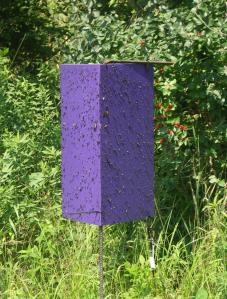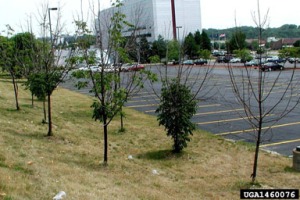After another long kid-related hiatus, I finally have some time to write, and I have luckily also come across a subject that piqued my interest after a simple walk in the neighborhood.

The color purple was chosen for its wavelength--adult emerald ash borers (and other kinds of insects) are attracted to the color, and the smell of a bait oil the traps are doused with.
A couple of weeks ago, I saw a strange, three-sided purple whatsit hanging in a tree. I was mystified, but my best guess was that it was some local artist’s public display, since it makes sense for the kind of neighborhood I live in. Two weeks later, I saw two more of them hanging in a park well removed from my artsy locale, so I finally gathered my wits to figure it out.
Turns out, those purple prisms are baited, glue-covered traps designed to attract the emerald ash borer, a beautiful jewel of an Asian beetle whose larvae have a knack for slowly and very effectively killing ash trees. The traps don’t bring the ash borer to the area — evidently, the beetles spread very slowly on their own — but the traps draw any adults present in an area so state forestry offices can try to pinpoint the “leading edges” of existing infestations.
I mentioned that the bug doesn’t really get far on its own. As far as the people in charge of tracking the insect can tell, the two main methods of spread are from people bringing firewood with them from home when they go on a camping trip, and affected nursery stock being shipped to places where the insect wasn’t before.
The emerald ash borer made its first public appearance in the United States in Michigan around 2002, having stowed away in wooden packing material from Asia roughly 10 years earlier. Despite a federal quarantine on shipping ash out of the state, the borer showed up in Fairfax County in 2003 after a Michigan tree nursery illegally sold infested ash saplings to a Prince George’s County nursery, which were then planted at a Fairfax elementary school. The county briefly got rid of the borer by chopping down several hundred trees in the affected areas, only to have it show up again in 2008, putting Virginia solidly in the “affected” category. Other states with EAB infestations and quarantines include Ohio, Indiana, Pennsylvania, Illinois, Maryland, Missouri, Wisconsin, and parts of Canada. And on May 14, 2009, Minnesota discovered the insects for the first time in the St. Paul area.

Adult emerald ash borer.
The USDA’s Forest Service writes:
Ash occurs extensively in the natural and urban forests of the Eastern United States. In 2001, ash accounted for more than 149 million cubic feet of timber products nationwide. It is estimated that more than a billion ash trees are growing in the United States, and about 800 million of these occur in Michigan. As of 2005, at least 15 million ash trees have died from EAB in Michigan alone. This loss is especially noticeable in urban areas where ash, once considered a hardy shade tree, was used to replace American elm trees after their demise from Dutch elm disease.
According to Minnesota’s Natural Resources Division, the state “has one of the highest volumes of ash on forestland in the U.S. with an estimated 867 million forestland ash trees,” and is also used frequently as an urban street tree for its beauty and hardiness. Separately, a 2007 paper studying the economic impacts of a 100 percent loss of Ohio’s ash cohort (over 4 million trees) estimated that to cut and replace dead and dying trees would cost the state and its citizens between $1.8 and $7.6 billion –that’s just one state, and just one type of pest.
There are some efforts underway to figure out what to do with all the dead wood — as there will surely be. Benches, baby furniture and baseball bats are a few of the things I came across.
Wondering if you have any ash trees that might be affected? The main sign is defoliation at the edges of the tree, along with the presence of “D” shaped exit holes where the larvae-turned-adult borers dig their way out from beneath the bark.

Tip defoliation of young ash trees, and vigorous suckering at the lower levels of the plant.

Adults leave a telltale D-shaped exit hole.
Or wondering what an ash tree even looks like? Maryland’s Department of Agriculture has a useful identification site.
So today’s moral is:

Actual billboard in Iowa.
